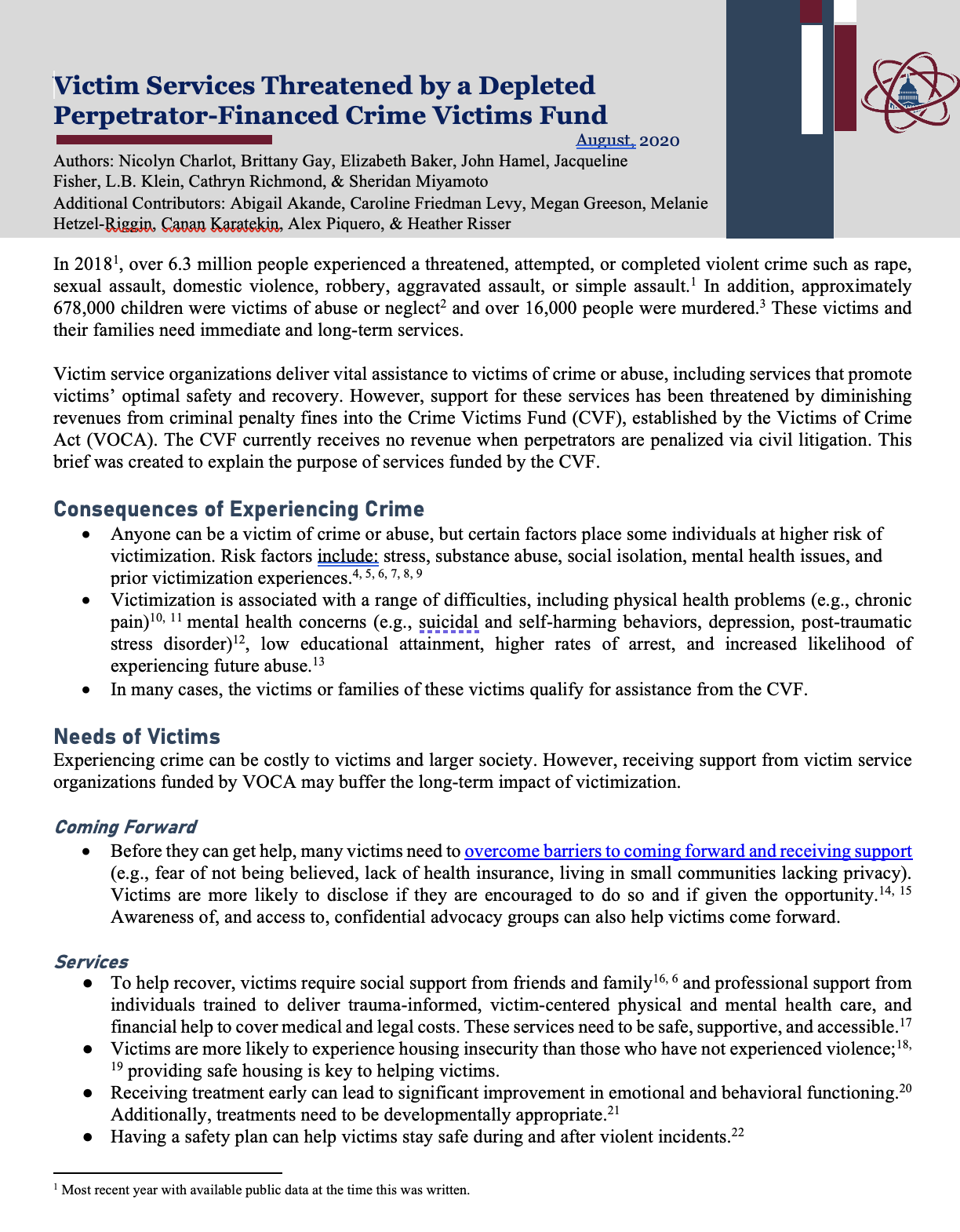
In 2018 [1], over 6.3 million people experienced a threatened, attempted, or completed violent crime such as rape, sexual assault, domestic violence, robbery, aggravated assault, or simple assault.[1] In addition, approximately 678,000 children were victims of abuse or neglect [2] and over 16,000 people were murdered.[3] These victims and their families need immediate and long-term services.
Victim service organizations deliver vital assistance to victims of crime or abuse, including services that promote victims’ optimal safety and recovery. However, support for these services has been threatened by diminishing revenues from criminal penalty fines into the Crime Victims Fund (CVF), established by the Victims of Crime Act (VOCA). The CVF currently receives no revenue when perpetrators are penalized via civil litigation. This brief was created to explain the purpose of services funded by the CVF.
[1] Most recent year with available public data at the time this was written.
Consequences Of Experiencing Crime
- Anyone can be a victim of crime or abuse, but certain factors place some individuals at higher risk of victimization. Risk factors include: stress, substance abuse, social isolation, mental health issues, and prior victimization experiences.[4,5,6,7,8,9]
- Victimization is associated with a range of difficulties, including physical health problems (e.g., chronic pain) [10,11] mental health concerns (e.g., suicidal and self-harming behaviors, depression, post-traumatic stress disorder) [12], low educational attainment, higher rates of arrest, and increased likelihood of experiencing future abuse.[13]
- In many cases, the victims or families of these victims qualify for assistance from the CVF.
Needs Of Victims
Experiencing crime can be costly to victims and larger society. However, receiving support from victim service organizations funded by VOCA may buffer the long-term impact of victimization.
Coming forward
- Before they can get help, many victims need to overcome barriers to coming forward and receiving support (e.g., fear of not being believed, lack of health insurance, living in small communities lacking privacy). Victims are more likely to disclose if they are encouraged to do so and if given the opportunity.[14,15] Awareness of, and access to, confidential advocacy groups can also help victims come forward.
Services
- To help recover, victims require social support from friends and family [16,6] and professional support from individuals trained to deliver trauma-informed, victim-centered physical and mental health care, and financial help to cover medical and legal costs. These services need to be safe, supportive, and accessible.[17]
- Victims are more likely to experience housing insecurity than those who have not experienced violence; [18,19] providing safe housing is key to helping victims.
- Receiving treatment early can lead to significant improvement in emotional and behavioral functioning.[20] Additionally, treatments need to be developmentally appropriate.[21] Having a safety plan can help victims stay safe during and after violent incidents.[22]
Best Practices Used By Victim Services Organizations
Many organizations that use evidence-based practices, such as those below, are reliant on VOCA funds, including victim-centered advocacy groups, emergency shelters, and mental and physical health service providers.[23]
- Cognitive Behavioral Therapy (CBT) can be effective at helping victims (e.g., with safety, substance use, mental health), particularly when tailored to victims’ needs.[24,25,26]
- Rapid rehousing and flexible funding programs are promising.[27] These programs assist victims by helping them find permanent housing or giving them financial support to prevent homelessness.
- Co-location service models (e.g., integrating child protection and domestic violence services) can improve outcomes for victims of violence (e.g., reduction in maltreatment rates and out-of-home placements, improved family functioning and stability), and improve service coordination.[28]
- Sexual Assault Nurse Examiners (SANE) collect forensic evidence, resulting in higher rates of successful prosecution of perpetrators.[29] These services improve physical and mental health outcomes for victims of sexual assault.[30]
Additionally, research suggests victim services organizations may be most helpful when they:
- Tailor their services to individuals based on diverse identities and at-risk backgrounds (e.g., victims of color, [6,31] migrants,[32] gender minorities,[33] LGBTQ+ individuals [34]).
- Incorporate victims’ input in service planning, delivery, and evaluation to narrow service gaps. This could include establishing advisory boards, hiring peer support specialists, creating tenant groups, and organizing policy advocacy initiatives.[35]
The Roles Of VOCA And The CVF
The unfortunate prevalence of crime and many crucial services provided by victim service organizations highlight their value, as well as the value of the existing programs and grants that help fund them such as VOCA and the Crime Victims Fund (CVF).
- VOCA provides over 4,000 awards annually to public and private nonprofit organizations that deliver crisis intervention services, emergency shelters, emergency transportation, counseling, and criminal justice advocacy.[36]
- The CVF is primarily funded by Federal criminal fines, not taxpayer dollars. This means the CVF, which assists an average of 3.7 million victims of all types of crime each year, does not place any burden on taxpayers. Unfortunately, deposits to the CVF fluctuate and the fund is currently depleting.[37]
- Without the funds provided through VOCA and the CVF, victim service organizations may struggle to help victims of crime, and victims will likely face difficulties in paying for the many costs that may arise in the aftermath of a crime, such as medical expenses, mental health services, funeral costs, and loss of wages.[23]
- Potential solutions to protect victim services could include match waivers, increasing funding to victim compensation programs, or redirecting some of the monetary penalties collected from deferred and non-prosecution agreements to the CVF.
In summary, research demonstrates victim service organizations are crucial for addressing multiple forms of violence and exploitation. Currently, Crime Victims Fund is one of the few or only sources of funding for effective victim services coordination across states, territories, and tribal lands. These funds are rapidly depleting and losing these funds could mean losing valuable programs. Funding victims’ service organizations is essential to ensuring they can continue providing support to those in need.
The Research-to-Policy Collaboration (RPC) works to bring together research professionals and public officials to support evidence-based policy. Please visit their website to learn more.
Key Information
RPC Website
Research-to-Policy Collaboration
Publication DateAugust 1, 2020
Topic Area(s)Violence and Victimization
Resource TypeWritten Briefs
Share This Page
In 2018 [1], over 6.3 million people experienced a threatened, attempted, or completed violent crime such as rape, sexual assault, domestic violence, robbery, aggravated assault, or simple assault.[1] In addition, approximately 678,000 children were victims of abuse or neglect [2] and over 16,000 people were murdered.[3] These victims and their families need immediate and long-term services.
Victim service organizations deliver vital assistance to victims of crime or abuse, including services that promote victims’ optimal safety and recovery. However, support for these services has been threatened by diminishing revenues from criminal penalty fines into the Crime Victims Fund (CVF), established by the Victims of Crime Act (VOCA). The CVF currently receives no revenue when perpetrators are penalized via civil litigation. This brief was created to explain the purpose of services funded by the CVF.
[1] Most recent year with available public data at the time this was written.
Consequences Of Experiencing Crime
- Anyone can be a victim of crime or abuse, but certain factors place some individuals at higher risk of victimization. Risk factors include: stress, substance abuse, social isolation, mental health issues, and prior victimization experiences.[4,5,6,7,8,9]
- Victimization is associated with a range of difficulties, including physical health problems (e.g., chronic pain) [10,11] mental health concerns (e.g., suicidal and self-harming behaviors, depression, post-traumatic stress disorder) [12], low educational attainment, higher rates of arrest, and increased likelihood of experiencing future abuse.[13]
- In many cases, the victims or families of these victims qualify for assistance from the CVF.
Needs Of Victims
Experiencing crime can be costly to victims and larger society. However, receiving support from victim service organizations funded by VOCA may buffer the long-term impact of victimization.
Coming forward
- Before they can get help, many victims need to overcome barriers to coming forward and receiving support (e.g., fear of not being believed, lack of health insurance, living in small communities lacking privacy). Victims are more likely to disclose if they are encouraged to do so and if given the opportunity.[14,15] Awareness of, and access to, confidential advocacy groups can also help victims come forward.
Services
- To help recover, victims require social support from friends and family [16,6] and professional support from individuals trained to deliver trauma-informed, victim-centered physical and mental health care, and financial help to cover medical and legal costs. These services need to be safe, supportive, and accessible.[17]
- Victims are more likely to experience housing insecurity than those who have not experienced violence; [18,19] providing safe housing is key to helping victims.
- Receiving treatment early can lead to significant improvement in emotional and behavioral functioning.[20] Additionally, treatments need to be developmentally appropriate.[21] Having a safety plan can help victims stay safe during and after violent incidents.[22]
Best Practices Used By Victim Services Organizations
Many organizations that use evidence-based practices, such as those below, are reliant on VOCA funds, including victim-centered advocacy groups, emergency shelters, and mental and physical health service providers.[23]
- Cognitive Behavioral Therapy (CBT) can be effective at helping victims (e.g., with safety, substance use, mental health), particularly when tailored to victims’ needs.[24,25,26]
- Rapid rehousing and flexible funding programs are promising.[27] These programs assist victims by helping them find permanent housing or giving them financial support to prevent homelessness.
- Co-location service models (e.g., integrating child protection and domestic violence services) can improve outcomes for victims of violence (e.g., reduction in maltreatment rates and out-of-home placements, improved family functioning and stability), and improve service coordination.[28]
- Sexual Assault Nurse Examiners (SANE) collect forensic evidence, resulting in higher rates of successful prosecution of perpetrators.[29] These services improve physical and mental health outcomes for victims of sexual assault.[30]
Additionally, research suggests victim services organizations may be most helpful when they:
- Tailor their services to individuals based on diverse identities and at-risk backgrounds (e.g., victims of color, [6,31] migrants,[32] gender minorities,[33] LGBTQ+ individuals [34]).
- Incorporate victims’ input in service planning, delivery, and evaluation to narrow service gaps. This could include establishing advisory boards, hiring peer support specialists, creating tenant groups, and organizing policy advocacy initiatives.[35]
The Roles Of VOCA And The CVF
The unfortunate prevalence of crime and many crucial services provided by victim service organizations highlight their value, as well as the value of the existing programs and grants that help fund them such as VOCA and the Crime Victims Fund (CVF).
- VOCA provides over 4,000 awards annually to public and private nonprofit organizations that deliver crisis intervention services, emergency shelters, emergency transportation, counseling, and criminal justice advocacy.[36]
- The CVF is primarily funded by Federal criminal fines, not taxpayer dollars. This means the CVF, which assists an average of 3.7 million victims of all types of crime each year, does not place any burden on taxpayers. Unfortunately, deposits to the CVF fluctuate and the fund is currently depleting.[37]
- Without the funds provided through VOCA and the CVF, victim service organizations may struggle to help victims of crime, and victims will likely face difficulties in paying for the many costs that may arise in the aftermath of a crime, such as medical expenses, mental health services, funeral costs, and loss of wages.[23]
- Potential solutions to protect victim services could include match waivers, increasing funding to victim compensation programs, or redirecting some of the monetary penalties collected from deferred and non-prosecution agreements to the CVF.
In summary, research demonstrates victim service organizations are crucial for addressing multiple forms of violence and exploitation. Currently, Crime Victims Fund is one of the few or only sources of funding for effective victim services coordination across states, territories, and tribal lands. These funds are rapidly depleting and losing these funds could mean losing valuable programs. Funding victims’ service organizations is essential to ensuring they can continue providing support to those in need.
The Research-to-Policy Collaboration (RPC) works to bring together research professionals and public officials to support evidence-based policy. Please visit their website to learn more.

Key Information
RPC Website
Research-to-Policy Collaboration
Publication DateAugust 1, 2020
Topic Area(s)Violence and Victimization
Resource TypeWritten Briefs
Share This Page
LET’S STAY IN TOUCH
Join the Evidence-to-Impact Mailing List
Keep up to date with the latest resources, events, and news from the EIC.




